
|
![]()
Greatest Films of the 1940s
1940 | 1941 | 1942 | 1943 | 1944 | 1945 | 1946 | 1947 | 1948 | 1949
Title Screen Film Genre(s), Title, Year, (Country), Length, Director, Description 

Cabin in the Sky (1943), 98 minutes, D: Vincente Minnelli
Director Vincente Minnelli's debut film, released in sepia-tone, was a noteworthy film from the Alan Freed production unit at MGM. It was based on Vernon Duke-Lynn Root's hit 1940 Broadway musical (directed by George Balanchine), and was Hollywood's first general release of an all-star, all-black musical, taken directly from its original Broadway production. It was only the fourth all-black cast film to be made, after Hallelujah (1929), Hearts in Dixie (1929), and The Green Pastures (1936). It starred the Duke Ellington Orchestra and Louis Armstrong as the Trumpeter, and Cab Calloway, and was noted as having the first appearance of the "moon walk" dance step. Its many songs included Arlen and Harburg's "Happiness is a Thing Called Joe" - nominated for Best Song. While the film was pretty dated and contained some racial stereotypes, it was marked by great musical performances, the most noteworthy of which came from Waters, who performed the hit standards "Taking a Chance on Love" and the Oscar-nominated Best Song "Happiness is a Thing Called Joe." Waters was a trailblazer for African-American performers, becoming the first African-American star of a national radio show before becoming the titular star of television's The Beulah Show. The delightful, energetic, and extravagantly-executed story, really a moralistic Faustian fable, told about a tug of war between good and evil. It told about a boozing and womanizing Joseph 'Little Joe' Jackson (Eddie Anderson with his first and sole film role, later known for his popular appearances as "Rochester" with Jack Benny on radio and TV), a shiftless gambler of questionable morals, who was having a lustful, extramarital affair. He was shot and killed at the Paradise Club during a barroom-brawl argument over his gambling debts. Immediately in a fantasy dream sequence, there was competition for his soul between God's General (Kenneth Spencer) in Heaven and the Devil's son Lucifer Jr. (Rex Ingram) in Hell. The General was summoned by the prayers of his gospel-quoting, devoted and religious wife Petunia Jackson (Ethel Waters). It was decided that Little Joe's soul would have a trial period of six months on Earth, to test his virtue and see whether he would reform. Lucifer Jr. tempted him with winning $50,000 in the Irish Sweepstakes, and added an additional temptation - the seductive alluring charms of the evil, sultry and beautiful singer Georgia Brown (Lena Horne). The sexy temptress was sent by the devil to win over Little Joe's soul and force him to give up Petunia. [Note: In the same year, screen legend Lena Horne also starred as Selina Rogers in Stormy Weather (1943).]



Fires Were Started - (1943, UK), 63 minutes, D: Humphrey Jennings
This classic, dramatized (or recreated) British wartime documentary was made by the Crown Film Unit with director Humphrey Jennings (his sole feature film). It was created as a tribute to the civilian fighters of London's Auxiliary (or Voluntary) Fire Service during WWII. It told about the heroic firefighting missions of a crew to save some of London's structures from burning, during Luftwaffe blitz bombing raids in 1940 during the night, signaled by air-raid sirens and anti-aircraft fire. It followed, over a fictional 24-hour period, the experiences of well-educated new recruit Barrett (William Sansom), a former advertising copywriter just transferred to the unit. In the firestation, he joined others as they prepared for a night of fire-fighting at an explosives warehouse near the Thames docks of London's East End.


Forever and a Day (1943), 104 minutes, D: Rene Clair, Edmund Goulding, Cedric Hardwicke, et al
This historical, episodic Hollywood film featured a large all-star cast of film stars of the 30s and 40s, to promote the British-American war cause. Filmed by many directors, it was the story about the inhabitants of a great manor house in London over many generations. The manor's history spanned more than 100 years from the time of its construction in Napoleonic times in the early 1800s by Admiral Eustace Trimble (C. Aubrey Smith) to the WWII blitz of London in 1940. It was a great war morale booster highlighting the themes of British patriotism and England's survival from diverse threats as the house passed through the hands of many generations. Memorable parts and cameos were played by Charles Laughton (as comic butler Bellamy), Cedric Hardwicke and Buster Keaton (as plumbers Mr. Dabb and Wilkins), Claude Rains (as villainous patriarch Ambrose Pomfret), Jessie Matthews (as Mildred Trimble), Edward Everett Horton (as bumbling father Sir Anthony Trimble-Pomfret), Elsa Lanchester (as waitress-maid Mamie), Brian Aherne (as coal-man Jim Trimble), Ida Lupino (as feisty house-maid Jenny Jones), Roland Young and Gladys Cooper (as Mr. and Mrs. Henry Barringer, the parents of a WWII ace flyer who never appeared), and many, many more.



For Whom the Bell Tolls (1943), 170 minutes, D: Sam Wood
Director Sam Wood's lengthy dramatic screen version of Ernest Hemingway's 1940 controversial best-selling classic adventure novel of the Spanish Civil War in 1937 was about a passionate relationship between two individuals caught in the conflict. A Montana schoolteacher turned American mercenary Robert Jordan (Gary Cooper) fought for the Republican Loyalists against Franco's Nationalists (or Fascists), alongside a motley group of untrained Spanish guerrilla peasants, led by chieftain El Sordo (Joseph Calleia) and unstable alcoholic peasant Pablo (Akim Tamiroff) and his wife Pilar (Greek actress Katrina Paxinou), the rebels' de facto leader. The band of Loyalist resistance fighters was composed of a colorful group of characters and a cropped-haired refugee Maria (27 year-old Ingrid Bergman in her first color film), a Spanish orphan who had been emotionally traumatized after her mayoral father was murdered and she was raped by the enemy. The guerrillas struggled against overwhelming odds to destroy a strategic bridge behind enemy lines, and Jordan, a munitions expert, fell in love with blue-eyed, short-haired blonde Maria during their dangerous mission. Their passionate relationship included one of cinema's most famous kiss scenes as Maria pondered: "I don't know how to kiss or I would kiss you. Where do the noses go?" With a sobering ending, when Jordan broke his leg and had to be left behind after delivering a soliloquy to Maria: ("You go now, Maria...what I do now I do alone. I couldn't do it if you were here...There's no good-bye, Maria, because we're not apart") - as the bell tolled for his life and for the ill-fated couple.



Heaven Can Wait (1943), 112 minutes, D: Ernst Lubitsch
Director Ernst Lubitsch's heartwarming fantasy-romantic comedy from Fox Studios was the director's first and sole completed Technicolor film. This film was not to be confused with Heaven Can Wait (1978), a remake of the 1941 comedy/drama Here Comes Mr. Jordan. Wealthy old playboy Henry Van Cleve (Don Ameche) passed away, after leading a life with many romantic indiscretions, flirtations, and seductive escapades extending from his early childhood through the days of his love and marriage to beautiful midwesterner Martha Strabel (Gene Tierney). In "flashbacks" about his carefree life story from infancy to age 70, the self-incriminating sinner had to convince His Excellency (Laird Cregar), the devilish Lord of Darkness, that he deserved to be admitted for punishment and eternal damnation. As it turned out, the cavalier Van Cleve was revealed to be good-natured, warm, kind-hearted, and sensitive - deserving of Heaven instead. He was, in fact, both a good father to son Jack (Tod Andrews) and a loyal (though sometimes philandering) husband married for 25 years to the gorgeous Martha.


The Human Comedy (1943), 118 minutes, D: Clarence Brown
Director Clarence Brown's low-key, sentimental but moving, superbly-acted drama was based on an original story by William Saroyan. The film was narrated (in voice-over) by recently-deceased Mr. Macauley (Ray Collins), the father of a family of four children in Ithaca, a small California valley town. Their everyday life was affected by the events of World War II and the need to cope with new responsibilities and hardships. The teenaged Macauley son, Western Union bicycle messenger Homer (Mickey Rooney) had to deliver mostly tragic war news to families about wounded or killed boys. A series of vignettes highlighted life in Americana as he came into close contact with all the families in town. He worked with 67-year-old alcoholic telegrapher Willie Grogan (Frank Morgan). Members of Homer's family included older brother Marcus (Van Johnson) off fighting in uniform - in love with college-aged neighbor Mary (Dorothy Morris), and Homer's younger six year-old kid brother Ulysses (Jackie "Butch" Jenkins). Homer also had an older quiet college student sister Bess (Donna Reed) who was in love with telegraph office operator Tom Spangler (James Craig), Homer's boss, although Tom was engaged to upper-class socialite Diana Steed (Marsha Hunt). One day, Homer had to deliver the news to his own family (and his widowed harp-playing mother Mrs. Macauley (Fay Bainter)) that big brother Marcus had been killed in battle. Marcus' best friend and service pal, orphaned and parentless Tobey George (John Craven), was more or less adopted by the Macauley family after the heart-tearing news.


I Walked With A Zombie (1943), 69 minutes, D: Jacques Tourneur
Director Jacques Tourneur's zombie supernatural horror film, an other-worldly variant of the Jane Eyre novel by Charlotte Bronte, was produced by famed RKO producer Val Lewton, who had already worked on Cat People (1942) and would soon produce The Body Snatcher (1945). The low-budget, creepy film was very effective for its moody and atmospheric tone and visually-stylistic terror regarding dark family secrets, voodoo rituals and legends. The brooding, mystical melodrama told of the work of trained Canadian nurse Betsy Connell (Frances Dee). The retrospective film told in flashback was her narrated description, beginning with her recollection: "I walked with a zombie. It does seem an odd thing to say. Had anyone said that to me a year ago, I'm not at all sure I would have known what a zombie was...." Betsy was hired to care for matriarchal Jessica Holland (Christine Gordon), the catatonic (trance-like), sleep-walking, comatose and semi-paralyzed invalid wife of melancholy Paul Holland (Tom Conway), a sugar plantation owner on the West Indies-Caribbean island of St. Sebastian. Jessica's doctor claimed that her catatonic condition (with no will of her own, no speaking, and seemingly lobotomized) was caused by an incurable tropical fever. By mid-film, Betsy had slowly begun to fall in love with guilt-ridden Paul, when she learned that Paul and his younger, alcoholic half-brother Wesley Rand (James Ellison) had a difficult relationship. The two brothers had earlier quarreled over the love of the afflicted woman in a love triangle, and Wesley had an affair with Jessica. Afterwards, Wesley blamed Paul for Jessica's condition. Betsy was convinced that she could cure the "living dead" Jessica with a shot of insulin, but the shock treatment failed. She then learned from Jessica's native maid Alma (Teresa Harris) that a local voodoo priest had cured a woman with the same condition, and had brought the woman out of a catatonic state. Alma drew her a map to the "Home Fort" where a local voodoo ceremony would take place. In an unsettling nighttime scene, Betsy daringly escorted her patient, without permission, on a haunting, dream-like walk through the plantation's billowing cane fields to the ceremony. She had to pass animal sacrifices along the way. As she went through a crossroads, there was the abrupt and shocking appearance in the darkness of a huge, eerie, bug-eyed and towering zombie-like guard Carrefour (Darby Jones). Jessica was led to the dwelling (houmfort) of the voodoo worshippers. A major plot twist occurred next - Betsy entered a shack to consult with the voodoo witch doctor priestess, and discovered it was the matriarch of the family, Mrs. Rand (Edith Barrett) (who practiced voodoo in secret). When Mrs. Rand had discovered that her sons had fought over Jessica, Paul's wife, and threatened to break up the family (when Jessica threatened to run away with her lover Wesley), she had put a 'living dead' zombie curse on her. The disturbed Wesley continued to believe that Jessica was truly a zombie, and to rid her (and free her) of her condition, Wesley stabbed Jessica's heart with an arrow (mimicking a voodoo worshipper stabbing a doll). In a trance, after carrying her corpse to the sea, Wesley committed suicide by drowning. Carrefour - who had followed Wesley to the sea, brought Jessica's body back to the house. Now reunited with Betsy, Paul confessed to her that he would take her away from the island.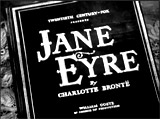

Jane Eyre (1943), 96 minutes, D: Robert Stevenson
Although made as Jane Eyre (1934) a decade earlier by the poverty-row studio of Monogram, this was the first talking version of Charlotte Bronte's classic 1847 romantic story set in Victorian times. This 40s version faithfully adapted Bronte's tale with typical Gothic elements, a brooding atmosphere, and Bernard Herrmann's rich score. The screenplay was based on an adaptation of the novel for Orson Welles' radio show, The Mercury Theatre on the Air. Mistreated, unloved orphan girl Jane Eyre (Peggy Ann Garner as 10 year old, Joan Fontaine as adult) was raised by mean and uncaring aunt Mrs. Reed (Agnes Moorehead) of Gateshead Hall. Arrangements were made for her to attend a boarding school named Lowood Institution, a charitable facility led by the harsh and self-righteous headmaster Reverend Henry Brocklehurst (Henry Daniell), where she befriended another student named Helen Burns (Elizabeth Taylor in an early uncredited role). At the age of 20, Jane was hired as the governess for a young girl named Adele (Margaret O'Brien) - the daughter of a wealthy Yorkshire Englishman. The huge mansion set on the bleak-looking moors of Yorkshire was called Thornfield Hall, and was run by housekeeper Mrs. Fairfax (Edith Barrett). Eventually, Jane met the darkly moody and hot-tempered owner, Edward Rochester (Orson Welles), and gradually was drawn into the mystery and dark secrets of Thornfield Hall - centering around a mysterious seamstress named Grace Poole (Ethel Griffies) who lived upstairs. Jane and Rochester also fell in love, and rather than marrying Blanche Ingraham (Hillary Brooke), Rochester asked for Jane's hand. The wedding ceremony was abruptly interrupted when an attorney contested the marriage - Rochester could not marry because he was still married to crazed, mentally ill spouse Bertha, who was guarded by Grace Poole. This was confirmed by Bertha's older brother Mason (John Abbott) of Spanish Town, in Jamaica. Jane was forced to depart from Thornfield, but returned after the death of her aunt to discover a burned-down Thornfield mansion. It had been set ablaze by Bertha, who jumped from the roof and died. Edward was also severely disabled, and left crippled and blind when the interior staircase collapsed on him. Jane remained and began to establish a relationship with Edward, and they were married. His sight miraculously began to return after the birth of their son.



The Life and Death of Colonel Blimp (1943, UK), 163 minutes, D: Michael Powell, Emeric Pressburger
Powell and Pressburger's satirical character study was a controversial wartime film that angered Winston Churchill for its portrait of a 'fuddy-duddy' 40 year career soldier, in the character of rotund Clive Candy (Roger Livesey). "Colonel Blimp" in the film's title referred to a 1930s English cartoon character, not a real personage. The Technicolor film that satirized the British military establishment used the name of Sir David Low's comic strip, The Life and Death of Colonel Blimp. Although completed in 1943, this film was not released for showing in the US until 1945, because it was banned for export from Britain due to its critical portrayal of staid British patriotism. The film told about the reminiscences of staunch, rigid traditional British soldier/officer Clive Candy as he looked back on his life through three wars - the Boer War, World War I, and World War II. He still maintained outdated notions about how to be a gentlemanly soldier and conduct war by following the rules, unable to adapt to the methods and realities of modern warfare. During his life, Candy kept a friendship with his German counterpart - a former German soldier Theo Kretschmar-Schuldorff (Anton Walbrook). During the course of his life, dedicated to the king and his country through changing times, he also met and loved three women: Edith Hunter / Barbara Wynne / Johnny Cannon (all played by Deborah Kerr in a very versatile role).


Madame Curie (1943), 124 minutes, D: Mervyn LeRoy
This intelligent and serious "prestige" MGM production was the result of the success of the Best Picture-award winning Mrs. Miniver (1942), in that it again paired Greer Garson and Walter Pidgeon (it was their third of nine full-length feature films together, after Blossoms in the Dust (1941) and their 1942 film). Paul Osborn's and Hans Rameau's screenplay (with help from an uncredited Aldous Huxley) was adapted from the 1937 book Madame Curie: A Biography, by Eve Curie, Marie Curie's real-life daughter. It was a dramatic, B/W historical film biography (or biopic), with meticulous attention to science, about the quest and research of two famous pioneering scientists, the husband and wife team of the Nobel Prize-winning Curies, who discovered radium. It opened in the 1890s with the introduction of the famous couple: shy and extremely-devoted physicist and avowed bachelor Pierre Curie (Walter Pidgeon) and a brilliant, poor but determined Polish student Marie Sklodowska (Greer Garson) at the Sorbonne working on her Master's Degree in Physics, who was recommended to work in Curie's laboratory. At first, he believed that no dedicated scientist could have any relationship with a woman ("No true scientist can have anything to do with women"). Their awkward and un-emotional but endearing love story, ending with a working partnership and marriage (to pursue their "common scientific dream") overcame obstacles and ridicule. They succeeded after a tedious, five-year experimental study in isolating and discovering a new and elusive radioactive element, radium. In the tragic conclusion, during a rainstorm, Pierre was run over by a horse-drawn carriage in the street and died. Twenty five years later (on the anniversary of their discovery) in the film's conclusion, continuing-researcher Marie lectured at the Sorbonne, declaring science "the clear light of truth" that could "in time cleanse this world of its evils, its ignorance, its poverty, diseases, wars, and heartaches." She ended by advising her youthful audience to "take the torch of knowledge and build the palace of the future."



The Man in Grey (1943, UK), 116 minutes, D: Leslie Arliss
This was the first of the quintessential Gainsborough Pictures costume melodramas, based upon the novel of the same name by Lady Eleanor Smith, with the themes of jealousy, doomed love and the elusive search for true love within a three-way love triangle. The psychological drama was told as a flashback by two strangers who met and realized that they were related descendants. They remembered their families' sordid history at an English estate auction (of the Rohan family) during WWII. The story revealed the fates of three characters - the first two met as female students at a boarding school and established a friendship: (1) the sweet, rich, innocent and beautiful heiress student Clarissa Marr (Phyllis Calvert), and (2) the unkind Hesther Snow (Margaret Lockwood), a charity case who was mistreated by the headmistress and compelled to run away. Clarissa had a loveless marriage to (3) the handsome but cruel, decadent and hedonistic "Man in Grey" - nobleman Marquis Lord Rohan (James Mason). Clarissa became only a "brood sow" to produce children for her husband. An impoverished and bitter Hesther went on to become a traveling Shakespearean play actress, and soon schemed to enter the Rohan household as a governess for the Rohan's young son, while she engaged in an affair with Lord Rohan. At the same time (although away from the country estate), Clarissa had an affair with one of the Shakespearean actors in Hesther's troupe, a rogue named Peter Rokeby (Stewart Granger), while Hesther plotted to take her place as Rohan's wife. This was facilitated after Clarissa caught a fever watching Rokeby's ship depart in the rain, and Hesther insured her death by drugging her and causing her to catch deathly pneumonia. When the truth was revealed to Lord Rohan about his wife's murder, he went into a rage and beat his new fiancee Hesther to death.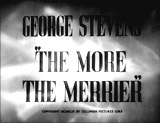


The More the Merrier (1943), 104 minutes, D: George Stevens
Director George Stevens' and Columbia Pictures' terrific war-time romantic comedy featured excellent performances and an effervescent flair, although it reflected a dark time period during the war years when Americans on the homefront faced many hardships. It was remade as Walk Don't Run (1966) with Cary Grant (his last film). In Washington DC during WWII, a housing (and single man) shortage developed, and young, prim and proper single working woman Connie Milligan (Oscar-nominated Jean Arthur) patriotically rented out part of her tiny apartment for a few days to an older, retired millionaire gentleman Benjamin Dingle (Oscar-winning Charles Coburn). Dingle decided to play Cupid for her, and rented out one-half of his half-apartment space to handsome Air Force airplane mechanic on special assignment Joe Carter (Joel McCrea), who was due to be shipped out to Africa shortly. In the midst of slapstick complications and humorous situations involving space and privacy, matchmaker Dingle was ultimately able to get the two romantically involved during his one-week trial period, although Connie continually and staunchly insisted that she was engaged to her pompous older boss - stuffed-shirt housing bureaucrat chief Charles J. Pendergast (Richard Gaines). The best scene in the film was a sexually-exciting brownstone apartment front steps kissing scene. Joe amorously embraced Connie - he caressed her, and fondly touched her hands, arms, and shoulders, and although she vainly attempted to ignore his advances to make out, she eventually took the two sides of his face with her hands and boldly kissed him back - harder. Her emotions for Pendergast were weakened by Joe's embraces and kisses. As they bedded down in adjacent rooms, they had their own version of the "Walls of Jericho" bedroom scene (from It Happened One Night (1934)) between their apartment windows. The scene was shot from outside in a frame split by the wall between them, when they discussed how uncomfortable and restless they were, and Joe finally admitted: "I love you Connie," and she responded likewise: "I love you more than anything in the world." Trouble briefly arose when Joe was arrested by the FBI after being falsely reported to be a foreign agent (a Japanese spy) by a misinformed, gullible neighborhood boy. When Connie, Dingle and Pendergast all showed up at FBI headquarters to offer denials, Connie's betrothed, self-centered beau felt scandalized by the situation (that Joe was cohabitating in an apartment with his fiancee). With Dingle, Pendergast suggested that to clear his name, Connie must marry Joe - and then she could seek an immediate annulment afterwards. She agreed with the idea, and Joe and Connie followed the scheme to avert the crisis. The two flew to South Carolina for a quickie marriage, and then returned to Connie's apartment. In their final night there, before Joe was to be deployed, Dingle had removed the wall separating their bedrooms. He delivered the final line - encouraging them to remain married: "Damn the torpedoes! Full steam ahead!"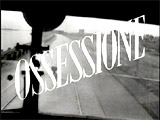


Ossessione (1943, It.) (aka Obsession), 140 minutes, D: Luchino Visconti
This early neo-realism film about a doomed and obsessed love affair (amour-fou) triangle was director Luchino Visconti's debut feature film. It was not related to director Brian De Palma's Obsession (1976) (a tribute to Hitchcock's Vertigo (1958)), but instead to James M. Cain's novel "The Postman Always Rings Twice" - and the two US film versions: the classic film noir in 1946 with Lana Turner and John Garfield, and the 1981 remake with Jessica Lange and Jack Nicholson. Without crediting Cain, Visconti made the film almost four years before the hard-boiled Hollywood version. Its explicit depiction of sex (and its homoerotic subtext) caused it to be banned by the Church, and ruthlessly edited and censored by Italian Fascist authorities, and the negative was destroyed. The only surviving film copy was Visconti's own slightly-shorter negative, which finally screened in the US in the mid-1970s, due to copyright issues. On the outskirts of Ferrara in Fascist Italy, virile, hot-headed and handsome drifter/car mechanic Gino Costa (Massimo Girotti) stopped at a small roadside inn (trattoria) and gas station, owned by old and corpulent Giuseppe Bragana (Juan de Landa). The proprietor was married to the restaurant's cook - the dissatisfied, beautiful, passionate and sexy wife Giovanna Bragana (Clara Calamai), who married only for financial security - to escape poverty and prostitution. While Giuseppe went to town on an errand, Gino and Giovanna had illicit sex together. When Gino could not convince Giovanna to run away with him, he left alone. Gino befriended a roaming entertainer called Il Spagnolo (the Spaniard) (Elio Marcuzzo) and they lived together (as homosexuals?) in a flop-house in the seaport town of Ancona, and worked together as street magicians-entertainers. When the two protagonists Gino and Giovanna had a chance encounter a few months later, the two impulsively murdered her inebriated husband Giuseppe, and made it look like a car accident. Although guilt-ridden and doubtful about their relationship, and suspicious of each other after Giovanna acquired a large life-insurance payout, the duo remained at the restaurant. However, Gino mistakenly believed that Giovanna had betrayed him to the police, although she denied it. The film ended abruptly with dire consequences - the brutal scene of pregnant Giovanna's accidental death in a car driven into the river by Gino - the film's second fatal car crash.

The Ox-Bow Incident (1943), 75 minutes, D: William A. Wellman
Director William Wellman's masterful noirish film was adapted from the well-known unconventional western tale by Walter Van Tilburg Clark. In a western setting, it superbly portrayed the tyranny and lawlessness of mob rule. It was basically a somber morality-play set in the West in the late 1880s, regarding vigilante justice. The thought-provoking film was the inspiration for Sidney Lumet's courtroom drama 12 Angry Men (1957). In Nevada in 1885, two cowboy drifters, Gil Carter (Henry Fonda) and Art Croft (Henry/Harry Morgan) rode into Bridger's Wells, a small Nevada cattle town. After learning about a rash of rustling incidents in the area, they quickly witnessed a lynch posse taking the law into its own hands without a fair trial. A local rancher named Larry Kincaid had allegedly been shot and killed during a cattle rustling, and a group quickly formed more intent on punishment than on justice. Storekeeper Arthur Davies (Harry Davenport) ineffectually implored that they cautiously not take any extreme actions until the Sheriff Risley (Willard Robertson) was notified about the alleged murder. The advice of Judge Daniel Tyler (Matt Briggs) was also powerless. With the Sheriff away, Deputy Sheriff "Butch" Mapes (Dick Rich) deputized the entire blood-thirsty lynch mob, led by pompous, vocal, and power-hungry Major Tetley (Frank Conroy), an ex-Confederate officer who took the law into his own hands. The demagogue Tetley was joined by iron-willed, heartless, cackling, blood-thirsty, robust Jenny "Ma" Grier (Jane Darwell). Each of the vengeful members of the cold-blooded posse-mob were superbly characterized, as the vigilante group rode off. At Ox-Bow Valley, they came upon three sleeping men with 50 head of cattle. They captured the men, including stoic, defiant Mexican hired hand Juan Martinez (Anthony Quinn) (identified as a wanted criminal named Francisco Morez) who at first feigned not speaking English, and senile, feeble-minded old man Alva Hardwick (Francis Ford, director John Ford's older brother). The third man was rancher Donald Martin (Dana Andrews) who claimed he bought the herd from Kincaid but had no bill of sale. It was impulsively assumed that he was a cattle rustler. Martinez had Kincaid's gun, which he said he found on the road. The mob conducted a quick trial (without due process) of the three innocent men despite only vague circumstantial evidence and pleas for justice and reason. Carter and Croft unsuccessfully attempted to prevent the dawn lynching of the three innocent men for alleged murder and cattle rustling (the vote among the 28 jurors was 21/7 in favor of hanging, instead of a hearing and trial in town). Shortly later, the group met up with the shocked Sheriff, who had just apprehended the real rustlers, and revealed that Kincaid was only wounded - and that they "caught the fellas who shot him too." In the film's epilogue set back in the town's saloon, Carter read the farewell words of Martin in a letter (a strong indictment of vigilante lawlessness) that he had written to his wife and two young children before the lynching. A collection was taken for Martin's widow, and the two drifters rode off after promising to deliver the letter.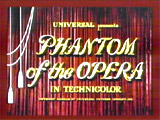



Phantom of the Opera (1943), 92 minutes, D: Arthur Lubin
Many versions of the 'Grand Guignol Phantom' tale, based upon the 1910 novel by Gaston Leroux, have stretched from Universal's silent classic The Phantom of the Opera (1925) with Lon Chaney and Mary Philbin, to this lavish Technicolored 1943 remake of the dramatic horror-thriller, to the more recent The Phantom of the Opera (2004) from director Joel Schumacher, starring Emmy Rossum and Gerard Butler. The 1943 film was notable for being the first film to feature popular star and tenor Nelson Eddy as the opera-singing hero after leaving MGM and his long-standing motion picture partnership with actress Jeanette MacDonald. It also won two Oscars: Best Color Cinematography and Best Color Art Direction. In the plot set at the Paris Opera House, the violinist in the opera's orchestra Erique Claudin (Claude Rains) had been anonymously funding voice lessons for three years for soprano opera singer Christine DuBois (Susanna Foster), whom he secretly worshipped. Due to the paralysis of part of his left hand, Erique was dismissed after twenty years of service by the opera's conductor Signor Ferretti (Leo Carrillo), and faced eviction from his apartment by his landlady. To raise money, Erique decided to sell a piano concerto ("Lullaby of the Bells") he had written, and mistakenly accused music publisher Maurice Pleyel (Miles Mander) of stealing his concerto. During a fit of manic rage, Erique strangled Pleyel to death, after which etching acid was tossed into his face by Pleyel's mistress-assistant Georgette (Renee Carson), horribly disfiguring him. From then on, Erique took refuge in the cellars and catacombs underneath the Opera House as a masked, caped figure. Christine found herself in the middle of a major love triangle involving three rival suitors: police Inspector Raoul Daubert (Edgar Barrier), baritone opera star Anatole Garron (Nelson Eddy), her true love, and Erique. Shortly later, stagehands at the Opera began speaking about the haunted Opera House that was being plagued by mysterious accidents and blackmailing threats, including written demands that Christine be promoted to the lead role to replace vain prima donna-diva Madame Biancarolli (Jane Farrar). Understudy Christine received a big career break after Biancarolli was first drugged by Erique to incapacitate her. Later, the diva was visited by the "Phantom" in her dressing room, where she unmasked the Phantom before she and her maid were strangled. Anatole vainly pursued after the Phantom above the opera stage, but afterwards was blamed for Biancarolli's murder. To draw the Phantom out, Inspector Daubert proposed to have another singer, Mme. Lorenzi (Niki Andre), replace Christine during an opera performance. In anger and to further terrorize the Opera House during the performance, Erique sawed through a heavy chain holding the chamber's massive chandelier, causing it to crash down upon the orchestra members in the auditorium. During the chaos, Erique absconded with Christine and brought her to his underground hideaway. After the Phantom expressed his love for Christine, the two heard the distant playing of Erique's piano concerto during the end of the opera show. Delighted, Erique began to play along with the piece on his piano, alerting both Anatole and the Inspector Raoul to the location of his whereabouts. Meanwhile, Christine ripped off Erique's mask - to reveal his disfigurement, at the moment that she was being rescued and saved. Pistol shots echoed throughout the subterranean lair, causing instability in the catacomb's ancient walls, and a major cave-in. Erique was buried alive and crushed to death in the falling debris, while Christine was saved just in time. In the conclusion, Christine decided to forsake both of her suitors-rescuers in favor of pursuing her singing career for her adoring Parisian public



The Seventh Victim (1943) (aka The 7th Victim), 71 minutes, D: Mark Robson
Horror master and RKO film producer Val Lewton was responsible for this creepy, doom-laden, noirish and Gothic thriller (Mark Robson's debut film), a low-budget black and white B-film (with a lesbian subtext) with the tagline: "SLAVE to SATAN!" It was a precursor to Roman Polanski's Rosemary's Baby (1968), and even had a Psycho-like shower sequence. In the enigmatic story, naive, orphaned young private school student Mary Gibson (Kim Hunter in her film debut) learned from convent nuns in her upstate NY Catholic school, Miss Highcliff's, that her older sister Jacqueline "Jackie" Gibson (Jean Brooks), the owner of La Sagesse, a successful cosmetics factory, had been missing for a number of months (and was not paying Mary's tuition). During a search in New York's Greenwich Village, she located errant Jackie's NYC apartment (a bare room with a chair and hangman's noose) above Dante's (an Italian restaurant), and learned that wealthy NY lawyer Gregory Ward (Hugh Beaumont) who was paying the rent - was her brother-in-law after a secret marriage to Jackie (although it had failed). [The film took a strange turn when Mary and Gregory fell in love with each other.] They also met a mysterious physician and psychiatrist, Dr. Louis Judd (Tom Conway), who had treated Jacqueline for depression. According to him, his pale and fragile patient had become obsessed with death and despair. In truth, Dr. Judd knew Jackie's location and was romancing her on the side. He belonged to an underground coven of witches, a deadly cult of diabolic Satanic worshippers called The Palladists. Shockingly, Jackie had given up her business and her soul to the possessed devil cultists. She found herself kidnapped and in their imprisoning grip, and condemned to die if she left the group. They wished to keep her from revealing her association with them by encouraging her to commit suicide (as the 7th departing victim!), or by assassinating her. Fearing for her life, Jacqueline had gone into hiding. In the conclusion, she escaped a suspenseful, lethal stalking by an assassin from the cult wielding a switchblade, then briefly made the acquaintance of consumptive and terminally-ill prostitute Mimi (Elizabeth Russell), a neighbor in her bleak rooming house, before entering her own empty apartment (# 7) and hanging herself (offscreen) in the surprise ending. Simultaneously, Mimi stepped out into the street for one last night of laughing and dancing.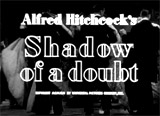


Shadow of a Doubt (1943), 108 minutes, D: Alfred Hitchcock
One of Alfred Hitchcock's most-suspenseful works (and his personal favorite) was based on a script by Thornton Wilder. The opening sequence identified the chilling, twisted, devious homicidal character of Uncle Charlie Oakley (Joseph Cotten) - the "Merry Widow Murderer" - evil personified from the very first scenes, as he fled from Philadelphia after committing a third murder of a rich widow. He suspected that his apprehension by police was imminent, and schemed to drop out of sight by visiting his adoring, middle-class relatives, including his unsuspecting, spinsterish older sister Mrs. Joseph (Emma) Newton (Patricia Collinge) in California. There were instances of telepathic twin-ness similarities and affinities between the congenial and suave Uncle Charlie and his symbiotic namesake - his young favorite niece "Charlie" (Charlotte) Newton (Teresa Wright) who was named for the uncle she idolized. At first, young Charlie was fascinated by her uncle's wit, urbane and worldly sophistication - but then a "shadow of a doubt" slowly began to emerge. Charlie rushed to the town's library just before it closed at nine pm, to see the contents of an article that Uncle Charlie had suspiciously cut out of her father's newspaper. In the reading room, she reacted dramatically -- her eyes widened as she found damning evidence that her Uncle was the "Merry Widow Murderer -- Strangler of Three Rich Women" - and that he was the object of a nationwide search. She also put two-and-two together - the initials engraved on the back of an emerald ring given as a gift to her by Uncle Charlie matched the initials of the murderer's third victim. In a key dinner table speech, a contemptuous, misogynistic monologue was delivered by Uncle Charlie - about his hatred for rich, lazily fat, detestable, middle-aged widows. As she approached closer to him and learned the truth, she realized that he was aware of her knowledge and suspicions. She had to decide whether she should reveal her findings to the authorities or protect her family. After her confrontation in a seedy bar with her uncle, she reluctantly agreed to not say anything if he promised to leave town soon, to avoid any scandal and to protect her mother from knowing that her younger brother was a murderer. There were two failed 'murder' attempts to kill young Charlie - a tampered-with broken step on the back stairs, and a malfunctioning garage door paired with carbon monoxide poisoning. In the exciting conclusion as Uncle Charlie was departing on the train for San Francisco (on the same train as widowed Mrs. Potter (Frances Carson), his next victim), he struggled between train-cars with young Charlie. She reversed positions with him, upset his balance and pushed him away - he fell headlong into the path of an oncoming, speeding train on an adjacent track.

The Song of Bernadette (1943), 156 minutes, D: Henry King
This dramatic and reverent film with a religious theme and expressive B/W Cinematography was adapted from the 1941 novel by Franz Werfel, retelling a story based upon a real-life person and event beginning in 1858. In the prologue, a quote appeared as a title card: "This is the story of Bernadette Soubirous who lived in Lourdes, a village in southern France close to the Spanish border. For those who believe in God, no explanation is necessary. For those who do not believe, no explanation will suffice." The title character was a young 19th century illiterate, simple-minded, asthmatic French peasant girl Bernadette Soubirous (Jennifer Jones (aka Phyllis Isley), in her first starring role for which she won the Best Actress Academy Award). She attended a convent school run by severe and devout Sister Marie Therese Vauzous (Gladys Cooper). One day in a grotto at the provincial French village of Lourdes, Bernadette had a glowing, rapturous and bright vision of a beautiful "Lady" dressed in white, interpreted by villagers to be the Blessed Virgin Mary (Linda Darnell). The "Lady" instructed her to return to the grotto daily for 15 days in succession. The film centered around all the various reactions to Bernadette's chosen-by-God vision and her daily pilgrimage, mostly skepticism, blasphemy, criticism, and ridicule, although there were some early believers. A spring with waters to heal the sick and disabled appeared suddenly and inexplicably at the site of her miraculous vision where she had been instructed to dig in the earth and rub mud over herself. Arrogant town elder and wicked Imperial Prosecutor Vital Dutour (Vincent Price) thought she was superstitious and fraudulent and making up her story, and became obsessed with committing her to an asylum. Faithful Bernadette steadfastly refused to recant her story and held fast to her beliefs. The discovery of the miraculous healing waters in the holy grotto helped many to believe in the naive girl's vision, and crowds began to accompany her. Believing pilgrims flocked to the healing spring to bathe in its Holy Water, at first prohibited by town politicians such as the Mayor of Lourdes Alphonse Lacade (Aubrey Mather), but then hypocritically encouraged. After a few years, 20 year-old Bernadette was accepted into the Convent of the Sisters of Nevers, now named Sister Marie Bernarde and under the watchful eye of her previous hard and resentful taskmaster Sister Vauzous. For many years, mortally-ill Bernadette without complaint suffered with a horrible leg tumor and incurable tuberculosis of the bone and steadily grew weaker, while still enduring questioning from the Episcopalian Commission. However, she remained steadfast in her beliefs. In the film's conclusion on her deathbed, Bernadette raised her head from the pillow and experienced a final visitation from the Virgin Mary who held out her arms, and smiled. Bernadette responded: "I love you! I love you! Holy Mary, Mother of God. Pray for me." After her death, Dean of Lourdes Father Peyramale (Charles Bickford) stated she was now in a state of grace: ("You are now in Heaven and on Earth. Your life begins, O Bernadette"). Superimposed bells began to peal from the church tower, and there was a chorus of "Hallelujahs."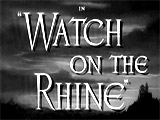


Watch on the Rhine (1943), 114 minutes, D: Herman Shumlin
This propagandistic, anti-isolationist war-time drama expressed the dangers and evils of Fascist thought. It was one of the best and well-made of all the anti-Nazi films of the war years. It was based on Lillian Hellman's Broadway play, and scripted by Dashiell Hammett. In the plot, German-born engineer Kurt Muller (Paul Lukas who won a Best Actor award, defeating Humphrey Bogart in Casablanca (1942)), a European Resistance underground leader, was forced to flee from Nazi Germany just prior to Pearl Harbor in order to find safe refuge in America. After 18 years in Europe, he and his American-born wife Sara (Bette Davis) and their three young children crossed the border from Mexico, and moved in with her brother David Farrelly (Donald Woods) and mother Fanny Farrelly (Lucile Watson), widow of a Supreme Court Justice in Washington D.C. Refusing to remain silent, Kurt explained to them the true nature and threat of the Nazis (and to the American public in a bit of propagandizing). He was confronted with the threat of being betrayed or blackmailed to Gestapo Third Reich agents (in the German Embassy) by other boarders in the home, especially treacherous blackmailing spy Teck de Brancovis (George Coulouris), an exiled Rumanian count who had married Marthe de Brancovis (Geraldine Fitzgerald), one of the Farrelly's daughters. Teck suspected that Kurt was a leader of the anti-Nazi underground after snooping in his locked briefcase. During a confrontation, Kurt cold-bloodedly shot Teck dead, and then explained to his wife Sara that it was a justifiable homicide before fleeing. In the conclusion, the oldest Muller son Joshua (Donald Buka) was already planning to return to Europe to fight Nazis with his father and/or attempt a rescue.